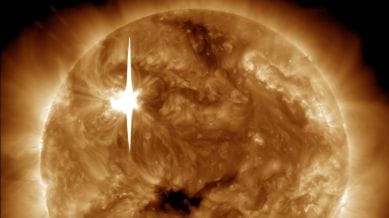Sun throws out strongest explosion in years on a day full of solar flares
The Sun is reaching "solar maximum" and it shows. It threw out three extremely strong explosions in a period of 24 hours.

The Sun sent out an extremely strong solar flare that peaked on Thursday, February 22 announced NASA. It was classified as an X6.3 solar flare, and X-class denotes the most intense flares, while the number indicates more about its strength, the higher the more. It was the third solar flare in a 24-hour periods as the Sun approaches solar maximum.
Solar flares are powerful bursts of energy that can potentially impacts radio communications, electric power grids, navigation signals and even threaten astronauts in space, satellites and spacecraft. The three solar flares all came from AR3590, a giant sun-spot. The other two were rated at X1.8 and X.17 respectively. And while they were powerful, they are not expected to cause any harm.
However, there could be minor G1-class magnetic storms on February 25th because a coronal mass ejection (CME) is expected to pass through Earth’s magnetic field, according to SpaceWeather.com. CMEs are when the sun throws out large amounts of plasma and magnetic fields. The three extremely powerful solar flares on February 22 did not produce any CMEs.
While geomagnetic storms do affect radio communication and could harm astronauts and assets in space they also come with a rather beautiful side effect — auroras. But do not be disappointed. The A3590 sunspot has an unstable “Beta-gamma-delta” magnetic field that still has enough energy for X-class explosions.
Sunspots like that are most common when the Sun reaches the peak of its cycle, with each cycle lasting around 11 years. We are currently in cycle number 25 and it is expected to peak sometime this year. But we will only know about the peak and identify when it happened about 6 months after it does.